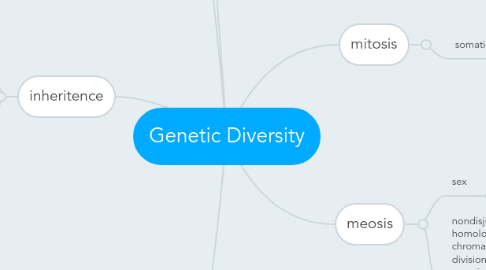
1. genes
1.1. chromosomes
1.1.1. locus: location of gene on a chromosome
1.1.2. linked genes: genes occupying the same chromosome
1.1.3. each chromosome contains one allele for each gene
1.1.4. homologous: pairs of chromosomes are different, different in alleles
1.2. Allele: alternate forms of the game gene
1.2.1. positions in gene where differences occur are called (single nucleotide polymorphisms) SNPS
1.2.1.1. same gene, different base sequence
1.2.2. alleles come from two different sources (egg and sperm)
1.3. haploid: 1 set of chromosomes
1.3.1. diploid: 2 sets of chromosomes
2. cell division (divides to create new cells)
3. to ensure genetic diversity
3.1. crossing over: exchange of genetic material, exchange different segments of genetic material
3.2. independent assortment: homologous chromosomes line up randomly, maternal and paternal chromosomes assort to each daughter cell
3.3. fusion of gametes: four different possibilities for each sex, 8 different types of fertilization
4. inheritence
4.1. heterozygous: 2 different alleles of a gene
4.1.1. homozygous: having identical alleles of a gene
4.2. dominant: dominant alleles show their affect even if the individual only has one copy of the allele. (capital letter), produces the same phenotype whether it's paired allele is identical (Rr, RR)
4.2.1. recessive: recessive alleles only show their effect if their individual has two copies of the allele (lowercase), an allele that produces its characteristics phenotype only when you have two of them
4.2.1.1. phenotype: the physical appearance or characteristic of an organism, expression of particular trait
4.2.2. codominant: pairs of alleles where both have an effect when they are present together (RR)
4.3. genotype: the genotype is the part (dna sequence) of the genetic makeup of a cell
4.4. gametes: sex cells, haploid, contain one allele of each gene, cells that fuse together to produce the single cell that is the start of a new life
4.5. sex linked genes: phenotypic expression of an allele related to the sex chromosome of the individual, ratios are different in males and females
4.5.1. sex linked or autosomal?
4.5.1.1. sex linked: carried on the sex chromosomes, either x or y, sex inherited with Y from male and X from female,
4.5.1.1.1. autosomal: carried on any other chromosome, not referring to sex chromosome, in each cell together with 2 sex chromosomes, x and y in a male and x and x in female
4.6. pedigree
4.6.1. pedigree: family tree, chart
4.6.1.1. circle = female
4.6.1.1.1. filled circle = affected
4.6.1.1.2. square = male
4.6.1.1.3. filled square = affected
4.6.2. carrier: have the gene for a disease but it does not express
4.7. punnet squares
4.7.1. used to analyze and predict the outcome of a cross between 2 individuals
4.7.1.1. monohybrid cross: one trait crosses between 2 organisms
4.7.2. autosomal recessive: needs 1 copy of the recessive trait from both parents to pass to children
4.7.2.1. autosomal dominant: only one parent needs to have 1 dominant copy to pass to children
5. meosis
5.1. sex
5.1.1. prophase 1
5.1.1.1. metaphase 1
5.1.1.1.1. anaphase 1
5.2. nondisjunction: Nondisjunction is the failure of homologous chromosomes or sister chromatids to separate properly during cell division. if non-disjunction is affected in meosis I, that will affect everything else
6. mitosis
6.1. somatic
6.1.1. prophase
6.1.1.1. metaphase
6.1.1.1.1. anaphase

